Understanding Kiteboarding Booties for Performance
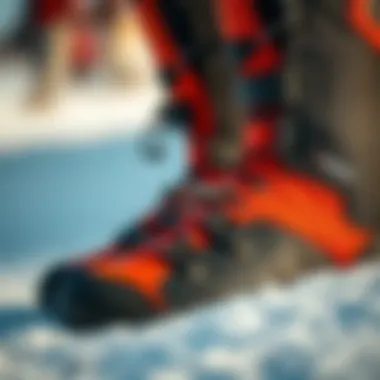
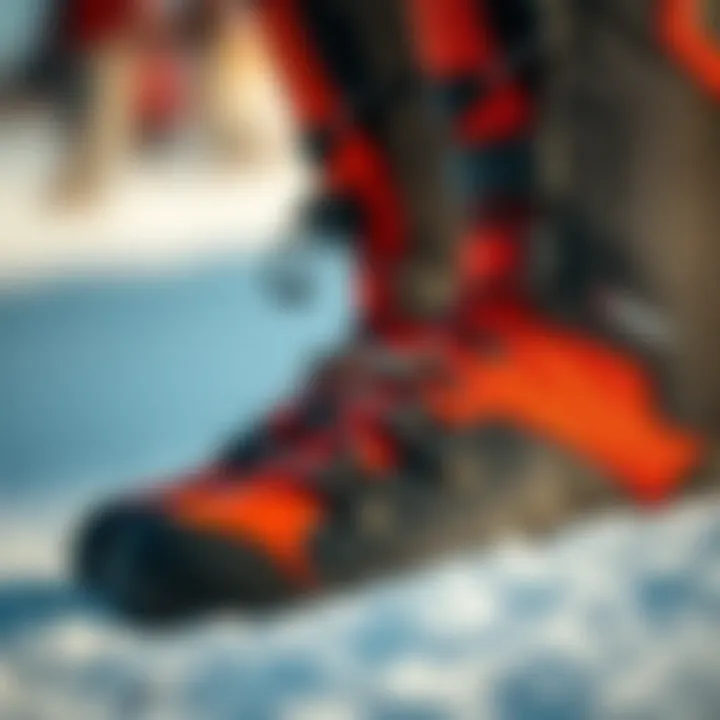
Intro
When you think of kiteboarding, your mind often drifts to soaring winds, the splash of the waves, and the thrill of riding the edge of nature. But, as any seasoned kiteboarder knows, the joy doesn’t just come from the kite or board. A crucial element often overlooked is the booties—those snug, protective foot coverings.
Booties play an indispensable role in comfort and performance on the water. They are not merely another accessory; they stand as a barrier between your feet and the elements. Understanding their importance helps elevate your whole kiteboarding experience.
In this guide, we will explore the different aspects that make kiteboarding booties vital. From the material choices that keep your feet warm and agile to sizing considerations that ensure a perfect fit, every detail counts. You’ll also learn how to maintain your booties for longevity and explore various styles that cater to different conditions and rider preferences.
Let’s dive deep into the world of kiteboarding booties—find the right pair, and you can ride the waves like a pro.
Gear and Equipment
When starting in kiteboarding, you may feel a bit lost amidst all the gear choices. Fear not; let's break it down. Choosing the appropriate booties is just as essential as selecting the kite or board itself.
Essential Kiteboarding Gear for Beginners
For newbies, it can be overwhelming to navigate the sea of options. Here are key gear components to kick-start your journey:
- Kite: Size and type will depend on wind conditions and rider weight.
- Board: Choose one that complements your skill level and riding style.
- Harness: Look for a comfortable fit to relieve pressure on your body while riding.
- Booties: A pair with a snug fit and good grip is vital. Neoprene is often the go-to material as it provides insulation and flexibility. Ensure they’re easy to slip on and off.
- Safety Gear: Don’t forget a helmet and impact vest for protection, especially when learning.
Advanced Equipment for Experienced Riders
As you gain proficiency, the focus shifts towards optimizing performance. Experienced kiteboarders often seek advanced booties tailored for specific conditions and intensive riding styles.
- Performance Booties: Thinner, high-performance materials enhance feel and flexibility.
- Warm Water Booties: Designed for tropical climates, these booties often offer less insulation but greater dexterity.
- Cold Water Booties: Thicker neoprene works wonders for warmth when riding in cooler climates.
For the seasoned kiteboarder, the choice of booties can accentuate both comfort and control in your ride.
"The right gear isn’t just about comfort, it’s about transforming your ride into a thrilling experience."
Understanding kiteboarding booties empowers riders to make informed decisions. Next, we’ll discuss the various styles available and offer tips for selecting the perfect pair.
Prolusion to Kiteboarding Booties
Kiteboarding is an exhilarating sport, but in order to truly enjoy the experience, the right gear is paramount. Amongst the trifecta of essential equipment — the kite, board, and harness — kiteboarding booties often don't get the attention they deserve. However, these specialized footwear play a crucial role in enhancing both performance and comfort out on the water.
At first glance, one might consider booties as just another accessory. Nevertheless, choosing the right pair can significantly influence your riding experience. They shield your feet from the elements, provide traction, and ensure that you maintain optimal control over your board when the wind hits just right. Imagine slicing through the waves only to feel the chill of the water oozing into your shoes — a discomfort no rider wants to face, especially while trying to catch that perfect breeze.
But why exactly are booties important? For starters, they offer excellent grip. When you're maneuvering on a board, a solid connection between your foot and the deck is key. Booties that are designed specifically with grip in mind can help prevent slips that might not only throw you off balance but can also lead to unfortunate spills.
Moreover, kiteboarding booties help to keep your feet warm. Depending on the conditions, water temperatures can be chilly, leading to numb extremities which can diminish your responsiveness on the board.
As you navigate through this article, you'll uncover the intricacies of different styles and materials, diving deep into essential sizing considerations and more. Knowledge about each aspect will equip you to make informed decisions when it comes to selecting your booties — and let’s face it, your performance and overall enjoyment on the water deserve that level of attention.
The Role of Booties in Kiteboarding
Booties play a pivotal role in kiteboarding, acting not just as a piece of equipment but as a key enhancer of a rider's overall experience. These specialized footwear options are crafted to provide comfort, safety, and efficiency, which are crucial when navigating the often unpredictable nature of the water.
Comfort and Protection
When one is out on the waves, the last thing you want is discomfort pulling focus from the excitement of the ride. Booties, particularly those made from neoprene, provide insulation against cold water, allowing for longer sessions without the dreaded chill setting in. They also offer a protective barrier against sharp objects lurking beneath the surface, such as rocks or debris. This safety factor cannot be emphasized enough; a nasty abrasion or cut can ruin what would otherwise be a fantastic day on the water.
- Insulation: Keeps feet warm in cooler temperatures.
- Protection: Shields from potential injuries caused by underwater hazards.
Moreover, they offer a sense of security when navigating over various terrains. Whether you’re launching off from a sandy beach or wading into a rocky area, booties facilitate grip and stability, which can significantly enhance performance.
Enhanced Performance
When kiteboarding, connection is everything. Booties help maintain an optimal connection between the rider and the board. They provide necessary feedback through the foot, allowing more precise control of movements and sharper turns while in mid-air. The right pair of booties will not only improve feel but also boost responsiveness, which is essential for mastering more advanced tricks.
- Improved Grip: Essential for maintaining control during high-speed maneuvers.
- Feedback and Control: Better connection improves performance and technique.
Weather Considerations
The significance of the right booties is amplified under varying weather conditions. In warmer climates, breathable materials can keep feet cool while still providing essential grip. In contrast, colder conditions call for insulated options to stave off the biting cold of the water. Here, the choice becomes not just about personal preference but vital to an enjoyable and safe experience.
"Selecting the correct booties can make the difference between a mediocre day and an exhilarating experience on the water."
Personal Style and Expression
An often overlooked aspect of kiteboarding booties is the element of personal style. Designs can vary significantly, from vibrant patterns to sleek minimalism, allowing kiteboarders to express individuality. While performance is paramount, the aesthetic appeal of booties can also enhance the fun of the sport.
Ultimately, understanding the role of booties is about more than just picking a pair that looks good. It’s about ensuring safety, enhancing performance, and allowing both novice and experienced riders to enjoy their time on the water to the fullest. When gear complements skill, the possibilities in kiteboarding are boundless.
Material Considerations
When it comes to kiteboarding booties, the materials used play a fundamental role in not just comfort but also performance on the water. Each type of material offers specific benefits, making it crucial for kiteboarders to understand their options. Selecting the right material can enhance your overall experience, prevent discomfort, and even affect your agility while riding.
Neoprene: The Standard Choice
Neoprene is the most common material used in kiteboarding booties. Its popularity stems from its excellent insulation and flexibility. Neoprene booties come in various thicknesses, which allows kiteboarders to choose the right kind based on the climate and water temperature.
What makes neoprene particularly beneficial is its water-resistance and quick-drying properties, so you won't spend more time in soggy boots than needed. It's also quite supportive, providing a snug fit around the foot which helps maintain control while maximizing performance. For example, a thick 5mm neoprene booty is ideal for colder waters as it traps body heat effectively. Meanwhile, thinner options are perfect for warmer conditions.
Thermal Properties
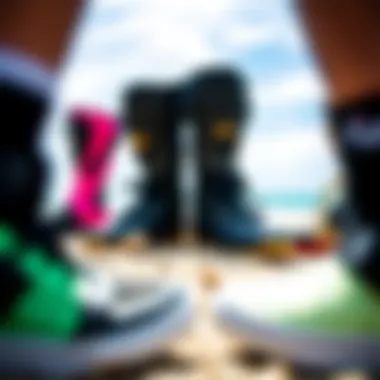
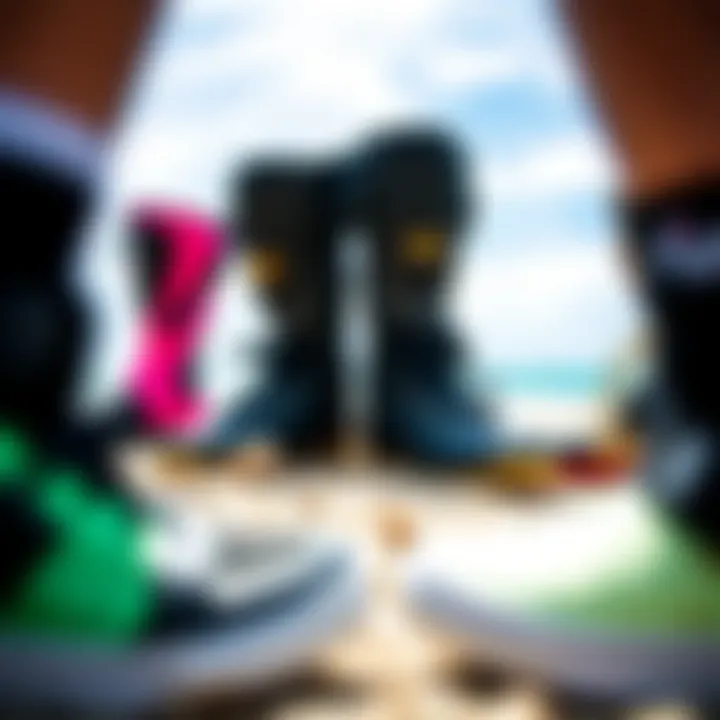
Thermal efficiency is a key factor when choosing kiteboarding booties, particularly for those who ride in cooler waters. A bootie's thermal properties will dictate how it manages heat and ensures your feet stay warm without overheating.
Some booties come with thermal linings, enhancing heat retention while still allowing for moisture-wicking to manage sweat. The balance between warmth and comfort is crucial; no one wants to feel like they are walking on hot coals when they are kiteboarding. Furthermore, when temperatures drop, an inadequate thermal property can quickly ruin your experience, making you less agile and even limiting your time on the water.
Non-Neoprene Alternatives
While neoprene is the industry standard, there are various non-neoprene materials gaining traction. Fabrics such as nylon or polyester can provide lighter options, reducing the weight of your gear without sacrificing much in terms of flexibility.
These alternatives often come with their own unique benefits. For instance, some composite materials are designed to enhance breathability and durability, while others feature waterproof treatments to keep your feet dry even if you take a dip. Many kiteboarders appreciate the lighter feel of non-neoprene options, particularly in warmer climates where over-insulation can feel like a drawback. However, those considering a non-neoprene bootie should weigh comfort against conditions; for colder waters, sticking to neoprene might still be the most reliable choice.
The material of your kiteboarding booties can significantly impact your comfort and riding performance. Choose wisely, and you'll enhance your time on the water.
Styles of Kiteboarding Booties
The style of kiteboarding booties plays a significant role in determining not only how you ride but also your overall comfort on the water. With various designs, each bootie style caters to individual preferences and specific conditions. For kiteboarders, understanding the nuances of each style can lead to better performance and, ultimately, a more enjoyable experience while navigating the waves.
Stitched vs. Glued Seams
When it comes to seams in kiteboarding booties, the debate between stitched and glued seams is a hot topic among riders.
- Stitched seams are generally considered more durable. They involve using a needle and thread to sew the neoprene pieces together, which can withstand wear and tear better than glued seams. Many enthusiasts argue that stitched seams offer superior resilience, especially when kiteboarding at high intensity.
- Glued seams, on the other hand, provide a more streamlined look and can result in a smoother exterior. These seams are often bonded with strong adhesive, which can make the booties more water-resistant and slightly lighter. However, glued seams might not hold up as well under extreme conditions. Some users report that they can come undone after prolonged exposure to saltwater or harsh elements.
Ultimately, the choice between stitched and glued seams will depend on your riding style and personal preferences. If you often push the limits of your skills, stitched seams might be the better option. But if comfort and water-resistance are your priorities, glued seams could also do the trick.
High-top vs. Low-top Designs
The difference between high-top and low-top booties is something that riders should not gloss over. Each design has distinct advantages that can cater to varying situations on the water.
- High-top booties usually extend above the ankle. This additional height is beneficial for providing extra support and warmth. If you're riding in cooler conditions, high-tops will likely keep your ankles secure, reducing the risk of spraining them during tricky maneuvers. They also prevent sand and water from entering the bootie, which is a bonus during long sessions.
- Low-top booties, in contrast, offer increased freedom of movement and a more lightweight option. Riders favor them for warmer climates when the last thing needed is extra heat or bulk. Low-top designs can permit more flexibility in foot rotation, which is crucial for some advanced tricks. The trade-off is often less ankle support and warmth.
Choosing between high-top and low-top designs involves contemplating what you need most: support and warmth or mobility and lightness.
Split Toe vs. Full Foot
The debate between split toe and full foot designs has long been a conversation starter in kiteboarding circles. Each design serves a specific purpose based on your riding style.
- Split toe booties provide enhanced dexterity by keeping the big toe separated from the rest of the foot. This design allows for better control and responsiveness when maneuvering and foot placement on the board. Riders looking for maximum precision often gravitate toward this style, as the split toe design can help with balance during high-speed turns.
- Full foot booties offer a more cohesive fit, ensuring that the entire foot is snugly enclosed. While they may not provide the same level of control as split toe alternatives, they excel in terms of warmth and comfort. This makes them ideal for beginner kiteboarders or those who prioritize comfort over nuanced performance.
The preference for split toe versus full foot booties ultimately comes down to what feels right for the rider. Trying out both styles might reveal which one suits your particular riding style best.
Sizing and Fit
When it comes to kiteboarding, the right equipment can make or break an experience. Among the most essential components are booties; ensuring they fit well is crucial for performance and comfort on the water. Sizing and fit directly influence how much control you have over your board and how comfortable your feet feel. If your booties are too tight, you risk cramps and discomfort. Too loose, and you might as well be wearing flip-flops when riding.
The right size bootie allows for optimal energy transfer between your foot and the board, thus enhancing your riding technique. In this section, we will explore the intricate aspects of bootie sizing and fit, providing guidance on choosing the right size, making adjustments for comfort, and common pitfalls to avoid.
Choosing the Right Size
Selecting the correct size for your kiteboarding booties is much more than finding a number. The sizing can vary significantly between brands and styles. The first step is to measure your foot. Use a ruler to get the length from heel to toe, and reference the sizing chart of the brand you're considering. However, keep in mind that even if you fall within a certain size range, foot shape plays a role as well.
Consider the following factors when choosing the right size:
- Foot Width: Some brands offer wider options, which is crucial for those with broader feet.
- Arch Height: Higher arches may find specific styles more comfortable.
- Footwear Layering: If you plan to wear socks or additional layers, take that into account.
Ultimately, you want a snug fit that does not restrict circulation.
Adjusting for Personal Comfort
Once you have selected the right size, it's time to fine-tune the fit to match your personal preference. This is where adjustability comes into play. Booties may come with additional features that allow you to switch things up according to your needs.
- Lacing Systems: Some booties feature laces or Velcro straps that allow you to customize how tight or loose the bootie feels.
- Insoles: If the booties come with removable insoles, swapping them for thicker or cushioned ones can enhance comfort, especially for longer riding sessions.
- Break-in Period: Keep in mind that some materials will stretch over time. It might be worthwhile to wear them around the house before hitting the waves.
Finding that sweet spot between snug and overly tight can make a world of difference in performance and enjoyment.
Common Sizing Mistakes
Even seasoned kiteboarders can make errors when it comes to sizing booties. Learning from these mistakes can save you both time and discomfort. Here are some common pitfalls to watch out for:
- Ignoring Brand Differences: Thinking all sizes are the same across the board. Different brands can size their booties differently. Always check individual sizing charts.
- Focusing Solely on Length: Some people only measure the length but ignore width and height. A well-fitting bootie includes all dimensions.
- Buying for Future Growth: While it can be tempting to buy a size up for future use, this could lead to instability when riding.
- Not Trying Before You Buy: If possible, try the booties on with the exact socks you'll use while kiteboarding. This will give you a clearer idea of how they will fit in real-world conditions.
"The right bootie can feel like an extension of your foot; get it right, and you're golden."
Weather Conditions and Booties
Understanding how weather affects your kiteboarding booties can be a game changer when you’re out on the water. The right pair can make all the difference, providing comfort, warmth, and protection. When the elements start to throw their punches, having the right gear is not just a preference; it’s essential!
Warm Weather Considerations
In hot weather, kiteboarding booties should keep your feet cool while providing enough grip and protection against rough surfaces. Neoprene booties, while versatile, can be a bit thick under the sun. Many enthusiasts prefer water shoes or thin neoprene styles in these conditions. The breathability and lightweight designs allow for greater ventilation, which is crucial on hot days.
When selecting booties for warm weather, consider:
- Thickness: Look for thinner materials, ideally in the 2mm range. This thickness keeps your feet protected without causing overheating.
- Drainage holes: These features help water quickly exit, preventing the boots from holding excess moisture.
- Flexibility: A good warm weather boot should allow for maximum foot movement. You want them to feel like a second skin, allowing for better control while riding.
Being mindful of your booties in warmer conditions equates to better performance and an overall enjoyable kiteboarding experience.
Cold Weather Adaptations
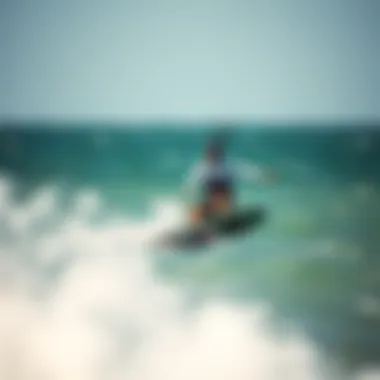
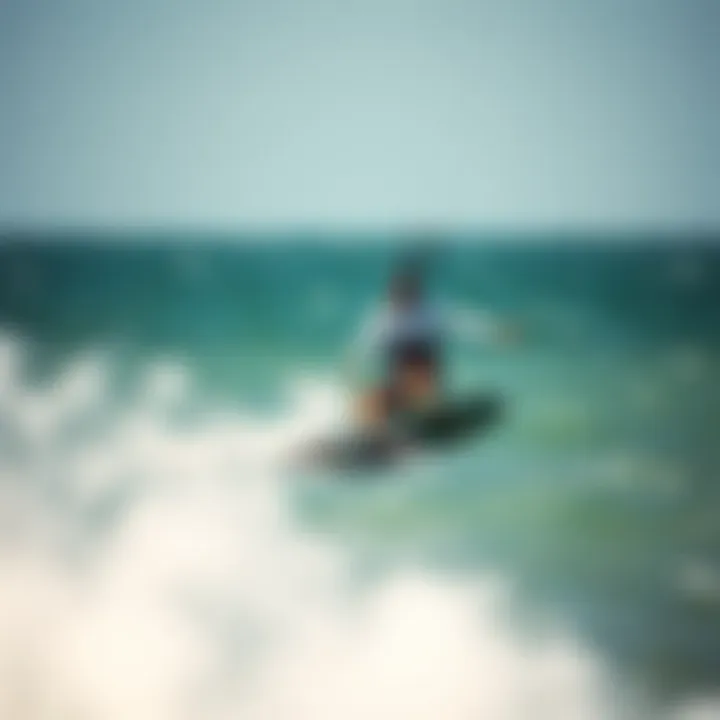
Cold weather can be a real buzzkill without the right gear. Kiteboarding in cooler temperatures demands booties that offer insulation and warmth, along with a solid grip. Neoprene thickness should be increased to at least 5mm to combat the chill and keep your feet cozy. Cold water can sap your energy fast, and numb toes can easily lead to a bad day on the water.
When the temperature drops, here are some features to look for:
- Increased insulation: Look for booties that boast features like lined inner walls which help retain warmth.
- Sealed seams: Cold water can creep in through flawed seams, making it important to choose booties with fully sealed or blind-stitched seams.
- Non-slip soles: Icy or damp surfaces can be treacherous. A sole with excellent grip can prove invaluable when you’re pulling off tricks or landing jumps.
"Having the right booties for the season not only protects your feet but enhances your whole riding experience. It’s about enjoying the sport without worrying about the cold or warm water effects."
Being wise about your choice of booties in cold weather can mean the difference between a short session and an epic day on the water. Adaptation is key. The wrong gear can lead to discomfort that lingers long after you’ve left the water, impacting your overall kiteboarding adventures.
Performance Enhancements with the Right Booties
When it comes to kiteboarding, the right equipment can be the difference between gliding effortlessly over the waves or struggling to maintain control. Kiteboarding booties aren't merely an afterthought; they're integral to performance and comfort. Properly chosen booties can enhance your riding experience remarkably.
Impact on Riding Technique
Booties designed specifically for kiteboarding can have a profound impact on your riding technique. The fit and feel of your booties can either support or hinder your movements. For instance, a snug fit ensures that your feet do not slip inside the booties, which can lead to a loss of control while executing tricks or maintaining balance. If your booties are too loose, they can create a clumsy connection with your board. On the contrary, a well-fitted pair will help in transmitting your weight shift directly, leading to precise rail engagement and smoother transitions.
Furthermore, booties with adequate traction on the soles provide the grip necessary for controlling the board during high-speed maneuvers. This grip allows for better edging, which is crucial when the wind picks up and you want to carve sharply into the water. For kiteboarders looking to master advanced techniques, the right booties serve as an unsung hero, enabling riders to execute complex aerials and jumps with a more consistent body positioning.
Support and Stability
Support and stability are the backbone of a successful kiteboarding adventure. Booties that provide adequate arch support can help alleviate pressure on the feet during long sessions on the water. If you're spending hours navigating through the waves, having cushion and support becomes a priority. Booties made with thicker soles can also help absorb the harsh impacts of landing, reducing strain on your feet and ankles.
It's not just about comfort; the stability offered by the right booties contributes to your performance. If you have an even distribution of weight and support in your feet, you are less likely to experience fatigue, allowing you to stay on the water longer and make the most of your session. Additionally, if you're negotiating different terrains—be it the choppy waves of the open sea or the smoother conditions of a lagoon—booties that offer flexibility in movement will allow you to adjust easily.
Therefore, investing in quality kiteboarding booties not only optimizes your performance but also enhances your overall enjoyment on the water. A simple pair of booties can truly elevate your riding journey, providing both the support and stability you need to push your limits further than ever before.
"The best kiteboarding booties are not just about keeping your feet warm; they’re about keeping you in sync with the board beneath you."
In summary, understanding how booties can influence your riding technique and offer the support and stability you need can significantly enhance your kiteboarding experience. Don't overlook this crucial element of your gear.
Maintenance and Care for Kiteboarding Booties
Taking care of your kiteboarding booties is as crucial as selecting the right pair for your water adventures. This vital gear not only protects your feet but also significantly influences your riding experience. Proper maintenance ensures that they last longer and perform well season after season, keeping your feet comfortable and safe from the cold or rough surfaces.
Cleaning and Drying Techniques
When it comes to maintaining your booties, cleanliness is king. After every session, rinse them off with fresh water to remove sand, salt, and other debris. Salt can degrade the material over time, leading to cracking or premature wear. Here are some practical steps for effective cleaning:
- Rinse Immediately: As soon as you finish riding, a good rinse will help prevent residues from setting in.
- Gentle Scrub: Use a soft brush or cloth to scrub away any stubborn dirt or sand particles. Be cautious not to use harsh cleaning agents, as they can harm the material.
- Dry Properly: After cleaning, air dry your booties at room temperature. Avoid direct sunlight or placing them on a heater, as extreme heat can distort the shape or compromise the material integrity.
Storage Recommendations
How and where you store your booties can make a world of difference in their longevity. An ideal storage place is cool and dry, away from direct sunlight. Here are some tips to ensure your booties stay in great shape:
- Avoid Crumpling: Never fold them tightly to fit into storage. Instead, keep them in their natural shape by using boot trees or stuffing them with newspaper.
- Use a Ventilated Bag: If you need to pack them up, opt for a breathable mesh bag. This helps prevent moisture buildup, which can lead to mildew and unpleasant odors.
- Rotate Usage: If you have multiple pairs, consider rotating between them. This gives each pair ample time to recover from use, extending their life.
Identifying Wear and Tear
As with any gear, keeping an eye out for signs of wear and tear is essential for ensuring safety and comfort. Look for these indicators:
- Stitch Damage: If you notice frayed or loose threads, it might be time to either repair or replace. Weak seams can lead to water entry, reducing both warmth and support.
- Material Cracking: Over time, neoprene can become less flexible and develop cracks; that's a red flag indicating the booties are nearing the end of their lifespan.
- Odor Issues: A strong odor can signify bacterial growth from dampness. If cleaning doesn't help, it might indicate that it's time to invest in a new pair.
Keeping your kiteboarding booties in top condition means less hassle on the water and more fun in the waves. Consider these maintenance practices essential for every kiteboarder and reap the benefits of optimal performance all season long.
Comparative Analysis of Popular Brands
When it comes to kiteboarding booties, understanding different brands is like navigating a maze; there are numerous options, each with its own set of pros and cons. The quality, design, and features of booties can greatly influence a kiteboarder's experience on the water. Hence, a comparative analysis of popular brands is pivotal in making an informed choice. This section will dive into notable brands, highlighting unique characteristics, benefits, and factors to consider when selecting the right booties for your adventures.
Brand A: Features and Benefits
Brand A has become a household name in kiteboarding circles, known for its durability and comfort. The most significant feature of these booties is their robust construction using high-grade neoprene, which not only provides insulation but also flexibility. The seamless design contributes to a snug fit, minimizing water entry and keeping feet warm, even in cooler conditions. Moreover, Brand A's innovative tread patterns enhance grip on both the board and slippery surfaces, facilitating better control.
The benefits of choosing Brand A include:
- Enhanced Performance: Riders often report improved feel and responsiveness with these booties, which can lead to better handling during maneuvers.
- Long-life Span: The materials used resist wear and tear, ensuring your investment lasts for multiple seasons.
- Variety of Options: Whether you're a beginner or a pro, Brand A offers various styles tailored to meet different skill levels and preferences.
Brand B: Key Attributes
Known for its striking designs and color options, Brand B stands out for aesthetic appeal, but it's not just a pretty face. The booties feature a unique drainage system that allows water to escape quickly, reducing the slosh effect common in many other booties. This attribute is particularly valued by riders who tackle waves or undertake intense sessions.
In addition to that, there’s also Lightweight construction, making them ideal for long hours on the water without feeling weighed down. Key attributes setting Brand B apart include:
- Quick-Dry Technology: This helps in keeping the booties light and comfortable, even after extended use.
- Integrated Arch Support: Riders with foot fatigue will appreciate the ergonomic design that supports arch stability during long sessions.
- Customization: Options for foot straps and colors allow users to personalize their gear.
Brand C: Value Proposition
Brand C markets itself as the budget-friendly choice without skimping on quality. Their booties might not offer as many high-end features, but they provide solid performance at a fraction of the price of competitors. This makes them a prime choice for newcomers or those who kiteboard on an occasional basis.
Some features that contribute to Brand C's value proposition include:
- Affordable Pricing: Competitive pricing makes these booties accessible to a wider audience.
- Satisfactory Comfort: While not as cushioned as higher-end models, many users find the comfort adequate for casual riding.
- Decent Durability: Users report longevity that meets expectations for regular use, striking a balance between cost and functionality.
In summary, understanding the nuances between different brands allows kiteboarders to select the best booties for their needs. Consumers should weigh elements like quality, comfort, aesthetic appeal, and price to make the most informed decision.
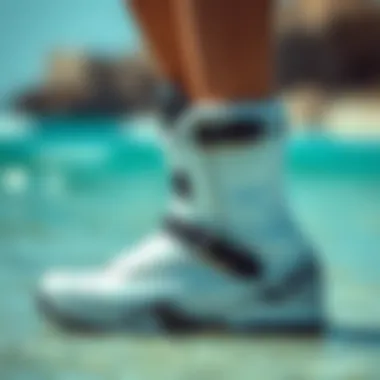
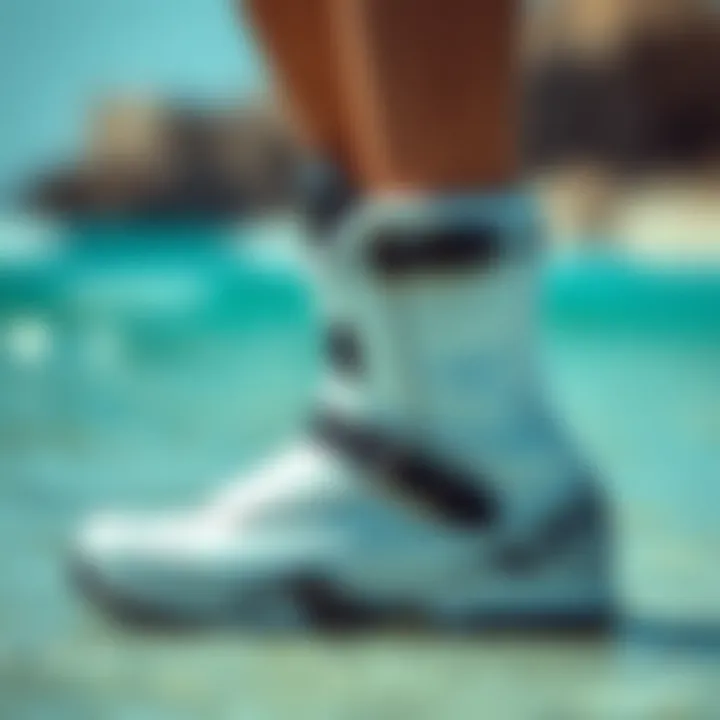
"The right gear can make a world of difference in your kiteboarding experience – from comfort on the water to performance in the air."
For further comparisons or discussions on these brands, forums like reddit.com or dedicated kiteboarding sites may provide testimonials and insights from fellow enthusiasts.
User Experiences and Testimonials
User experiences and testimonials hold significant weight in the realm of kiteboarding booties. These reflections from real users not only illuminate how a pair of booties performs under various conditions but also help potential buyers navigate the often overwhelming choices available. For anyone looking to invest in this crucial gear, first-hand accounts can provide insights that specifications and marketing descriptions might miss.
The Value of Real-world Feedback
When it comes to gear like kiteboarding booties, what's on the label often tells only part of the story. For instance, a bootie's comfort level can drastically vary from one user to another based on foot shape, riding style, and even the type of board being used. Feedback from fellow kiteboarders reveals how certain models can enhance or hinder performance
"I thought all booties were created equal until I tried a pair that really fit my style. Now, I can feel every pull of the kite more acutely. It's mind-blowing!" - Kiteboarder from California
Insights from Diverse Conditions
Users often provide valuable insights based on their experiences in different weather conditions. For instance, a rider who frequently tackles colder waters may highlight the thermal efficiency of a specific design, while another in tropical locales might focus on the breathability and quick-drying capabilities that cater to hot conditions. Consider the following:
- Cold weather riders: Many recommend booties with thicker neoprene, emphasizing the importance of keeping the feet warm without compromising flexibility.
- Hot weather enthusiasts: A lighter option with ventilation can make a world of difference in comfort after hours on the water.
Navigating Sizing and Fit
Testimonials can also address common sizing issues that new buyers might trip over. Many experienced users speak of the need to try on several pairs to truly find one that feels right. This trial and error process can save newbies from investments in booties that won't suit them on the water. Sharing stories of sizing mistakes made after relying solely on online charts can serve as a cautionary tale for others.
What's Worth the Hype?
Some brands receive rave reviews, with testimonials shedding light on their specific features. Buzz around a particular model may come from consistent discussions on platforms like Reddit, where kiteboarding communities gather to discuss gear. Users often delve into details like:
- Durability: How well the booties hold up after repeated use in challenging conditions.
- Grip and Traction: Real-world performance against slippery surfaces, crucial for a sport often played in dynamic environments.
Finale
While specifications and promotional content provide a framework for understanding booties, the heart of decision-making often lies in the voices of fellow riders. Engaging with user experiences fosters a sense of community and shared learning, ensuring that everyone—from rookies to seasoned veterans—can find the right pair of kiteboarding booties tailored to their unique requirements. Gathering insights and recommendations acts as a guiding compass in the sometimes turbulent waters of purchasing kiting equipment.
Budget Considerations
When diving into the world of kiteboarding booties, budget considerations are more than just a number; they're a vital part of your overall kitesurfing experience. Kiteboarding can be an expensive sport, where every piece of gear plays a role in performance and safety. Booties might seem like a small detail, but investing wisely in them can significantly affect your comfort and control on the water.
It’s essential to recognize that a higher price tag often, but not always, reflects better materials, construction, and durability. However, without careful thought, you might end up spending a fortune on something that doesn’t suit your needs. Here are some specific elements to consider:
- Functionality vs. Cost: A cheap pair might seem enticing, but if they don't provide the necessary grip or support, they could hinder your riding.
- Longevity: You want booties that withstand the test of time, especially if you're out in the water regularly. Spending a bit more on a quality product can save you money down the line.
- Reputation: Sometimes, well-reviewed brands offer mid-range prices that pack a punch in performance without breaking the bank.
By understanding these elements, you’ll be better equipped to make an informed decision about how to allocate your budget towards kiteboarding booties.
Finding Affordable Options
Navigating through the various options available for kiteboarding booties without draining your wallet can be a challenge, but it’s definitely doable. To find affordable options, consider the following tips:
- Sales and Discounts: Keep an eye on seasonal sales, especially towards the end of summer. Many shops offer great deals to clear out inventory.
- Secondhand Gear: Platforms like Facebook Marketplace or eBay can be goldmines for finding barely-used booties at half the cost.
- Local Shops: Don’t overlook local shops. They sometimes have special offers, especially for loyal customers or first-time buyers.
Getting the right pair of booties doesn't have to mean you must rob a bank. With patience and research, you can score a solid pair that won’t leave you high and dry financially.
Investing in Quality
While finding budget-friendly options is a good strategy, there comes a time when investing in higher-quality booties is crucial for your performance and safety. Here are several key reasons to consider quality:
- Enhanced Comfort: High-quality booties often come with improved designs that reduce chafing and discomfort over long sessions.
- Better Traction: Investing in booties with excellent grip can give you an edge, enhancing your confidence when navigating challenging conditions.
- Adaptability to Conditions: Quality booties are usually designed with varying weather conditions in mind, allowing you to perform better regardless of whether you're in warm or cool water.
- Long-term Savings: Though the initial investment might be higher, superior durability can lead to fewer replacements over time, making it more economical in the long run.
By weighing your options and understanding the balance between cost and quality, you're setting yourself up for success on the waves, ensuring you're prepped for whatever the weather throws your way.
The Future of Kiteboarding Booties
As the kiteboarding scene continues to evolve, so does the gear that accompanies it, particularly kiteboarding booties. The future of these essential pieces of equipment isn’t merely about improving comfort; it's also about enhancing performance and ensuring rider safety. Today’s market is experiencing innovations in design, materials, and functionality, which are all key factors affecting the user experience on the water.
One of the most significant trends is the integration of smart technology into booties. For instance, manufacturers are exploring the use of sensors that monitor water temperature and foot orientation. This data can help riders make informed decisions about their performance and improve their technique during sessions. As this technology becomes more accessible, it could standardize performance analytics within the kiteboarding community, allowing riders to compare their metrics and push their limits.
Additionally, sustainability is becoming a hot topic in gear production. More brands are shifting towards using eco-friendly materials and practices in their manufacturing processes. The objective here is not only to reduce environmental impact but also to cater to an increasingly eco-conscious consumer base. By adopting materials such as natural rubber or recycled plastics, companies can make a significant difference while retaining product durability and performance.
Benefits of Innovative Designs
- Improved Fit: The future will likely see booties designed with adaptive materials that mold to individual foot shapes. This would minimize discomfort and enhance riding precision.
- Enhanced Durability: Innovations in seam technology and material strength will lead to longer-lasting booties, which can withstand harsh conditions more effectively.
- Versatility: Expect designs that cater to various water conditions and riding styles, allowing for a single pair of booties to serve multiple purposes.
With the intensifying interest in performance gear, companies are also collaborating with professional kiteboarders for product testing and feedback. This kind of relationship fosters a more tailored approach to gear design, resulting in products that directly address the needs and preferences of the users. As riders share their insights, the manufacturing process becomes more dynamic, allowing for rapid advancements in booties technology.
Moreover, personalization could be a game-changer. In the not-so-distant future, riders may have the option to customize their booties in aspects such as cushioning levels, colors, and even features like arch support, which can significantly impact comfort and performance. This trend aligns with the broader movement in outdoor gear towards individual expression which resonates well with the kiteboarding community.
"The future of kiteboarding booties is not just about keeping feet warm; it's about creating a unique experience tailored to each rider’s needs."
Ending
In closing, the significance of selecting the right kiteboarding booties cannot be overstated. Their role extends beyond mere comfort; these booties are integral to optimizing performance while navigating the waves and winds. Choosing the appropriate pair directly affects flexibility, control, and even safety, all of which play pivotal roles in the overall kiteboarding experience.
When it comes to performance, booties crafted with the right materials can enhance grip on the board, providing the rider with better maneuverability. This is particularly relevant in adverse weather conditions where traction transforms from a convenience to a necessity. Moreover, the insulation offered by high-quality booties prevents the feet from getting cold, keeping a kiteboarder focused and agile.
Furthermore, understanding various styles and fits allows riders to personalize their experience and improve adaptability in different environments. A well-fitted bootie can help avoid common issues such as blisters or fatigue, ultimately contributing to a more enjoyable outing on the water.
"A good pair of booties is like a favorite pair of jeans; they should feel cozy and give you space to move around."
The insights shared in this article serve to underline not just the importance of booties but also how they influence various aspects of kiteboarding, from performance to durability. With careful consideration of factors such as material, fit, and intended use, kiteboarders can make informed choices that suit their style and the conditions they face.
In essence, investing time in understanding kiteboarding booties is crucial for enhancing one’s performance. Riders who prioritize this gear will likely find themselves enjoying their time on the water more fully, taking their kiteboarding skills to new heights.
For anyone passionate about kiteboarding, be sure to consult resources such as Wikipedia, Britannica, and lively discussions on platforms like Reddit to keep up with the latest trends and tips in the community.















